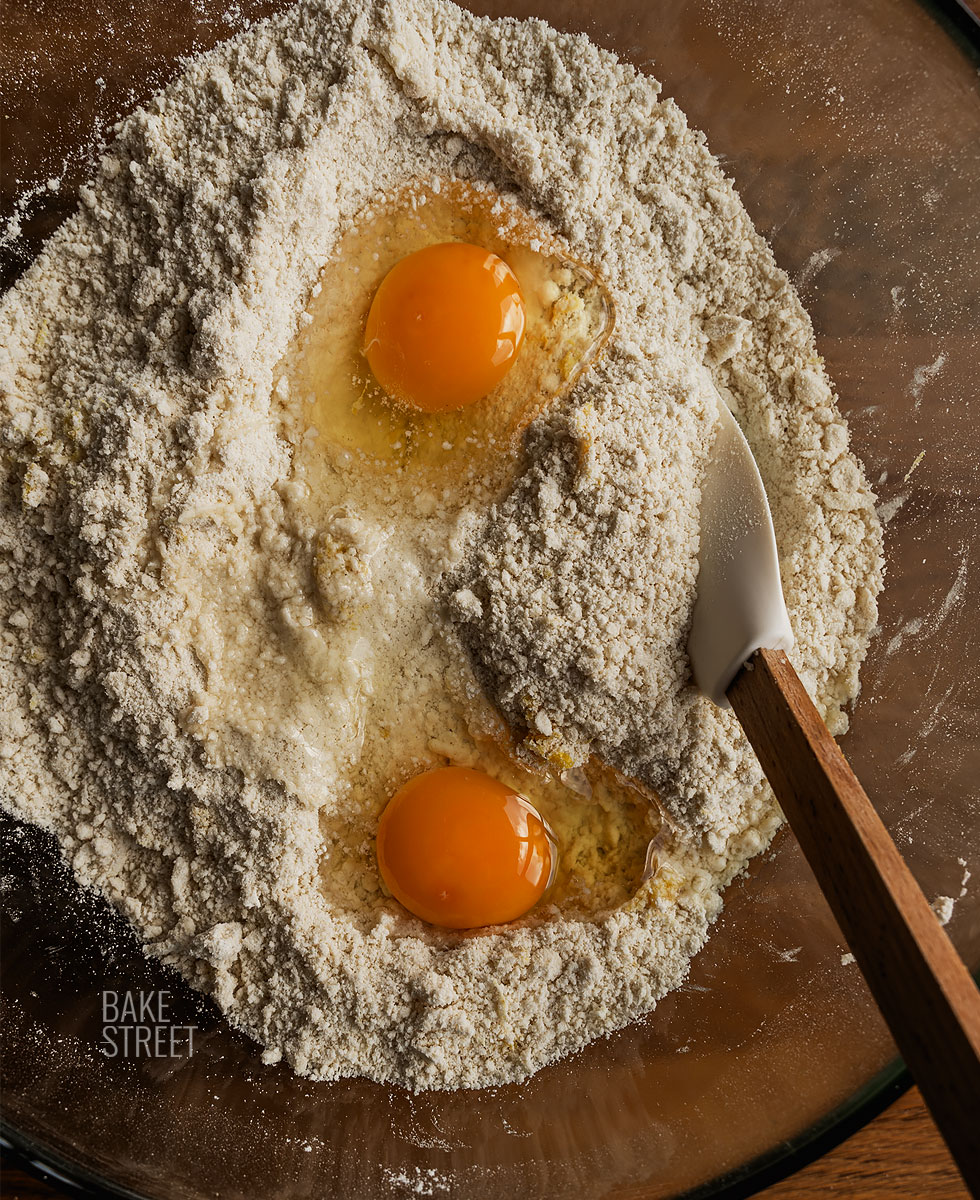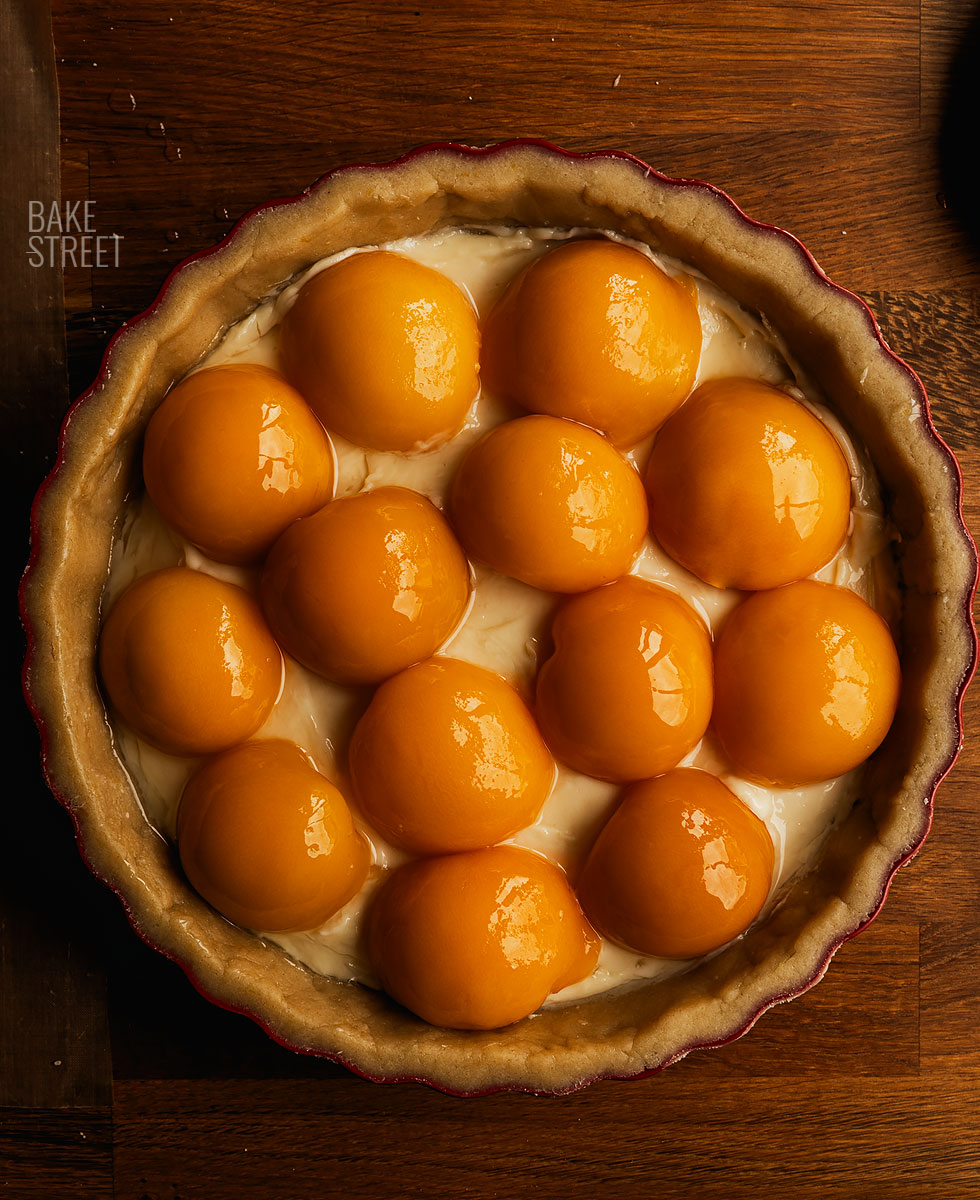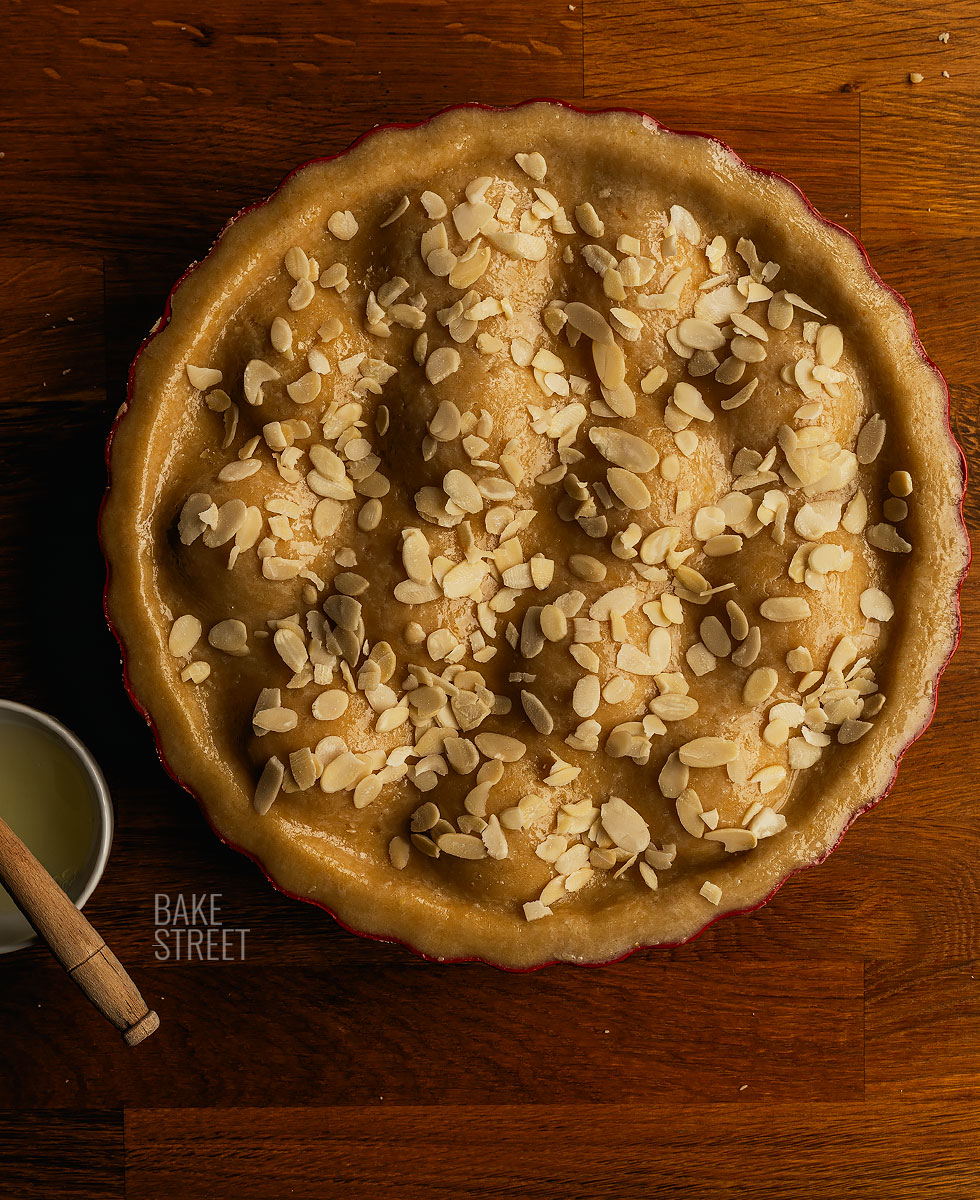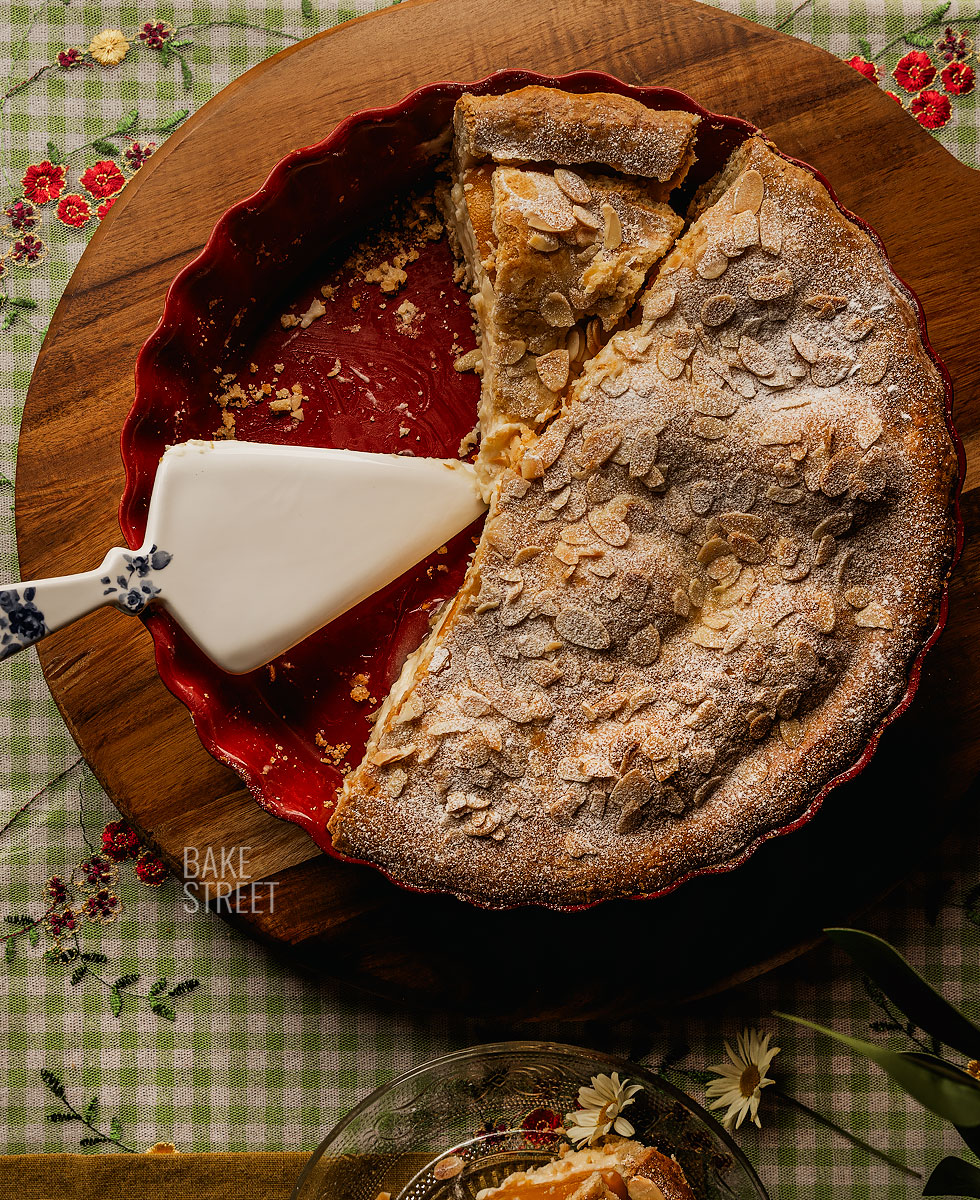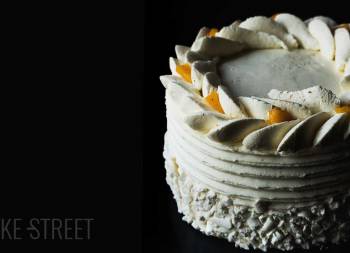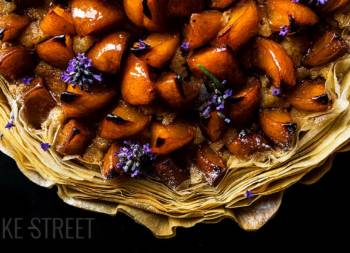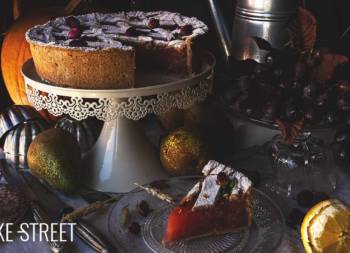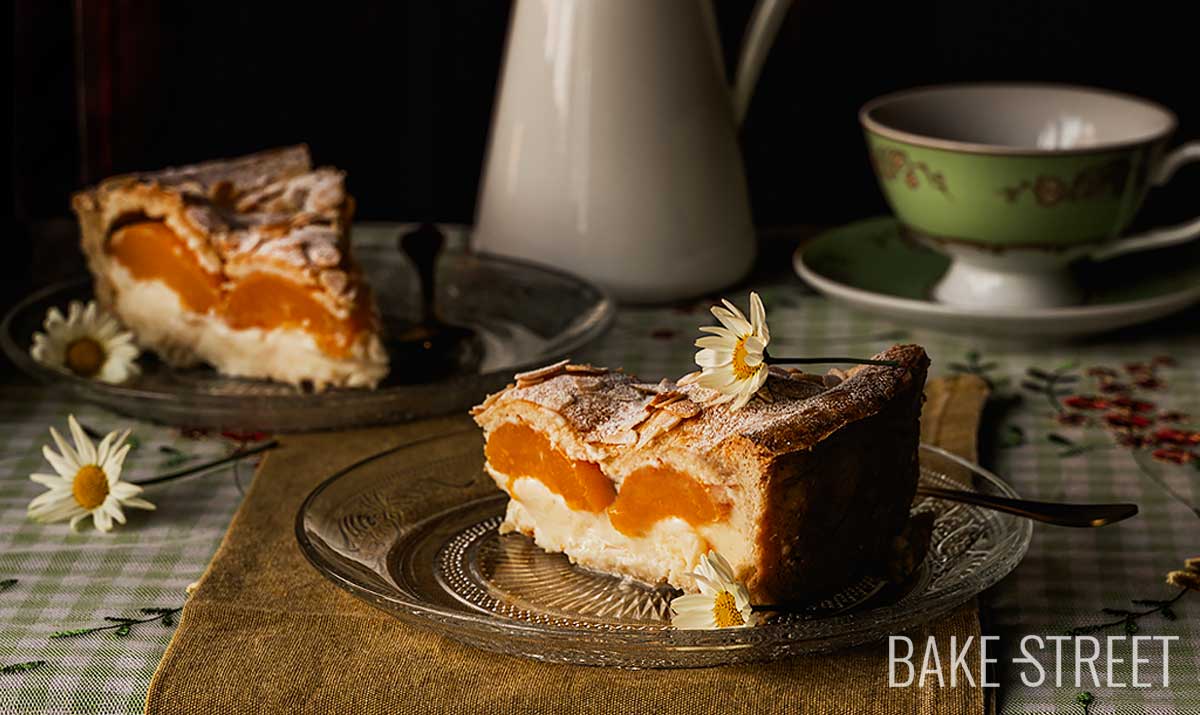
Peach and cream pie
I don’t know if it happens to you, but when spring comes I really want to prepare cakes or pies with fruits, combining sweet and citrus flavors. The preparation that I leave you today is not only very easy to make, but it will fascinate you in terms of flavor, aroma and texture. Peach and cream pie.
It may sound simple, but I promise it is wonderful. The dough is a frolla pastry flavored with lemon along with a filling of cream pastry witth cheese and yuzu jam accompanied by peach in syrup. It is an absolute fantasy.
I have been experimenting with the versatility of pastry cream for a few months now and I must say that it is a wonderful element to try with different ingredients just like ganache. This time I followed my pastry cream recipe and, once it was ready, I added cream cheese and yuzu jam. I can’t explain how extraordinary it tastes, not to mention the creaminess and smoothness of its texture thanks to the use of cream and cheese. Fascinating.
I know that yuzu jam is not very common in stores, in fact in my case I bought it in an Asian supermarket. But if you look for it, you will find it for sure. Otherwise, you can substitute it with orange marmalade (I would recommend bitter), lemon marmalade or even concentrated yuzu paste.
Before I continue, I want to thank Fatto in Casa da Alba because I fell in love with her recipe and I could not let much time pass without trying to make it at home. I have modified the recipe she shares, but the presentation is totally based on hers, thanks a lot, Alba!
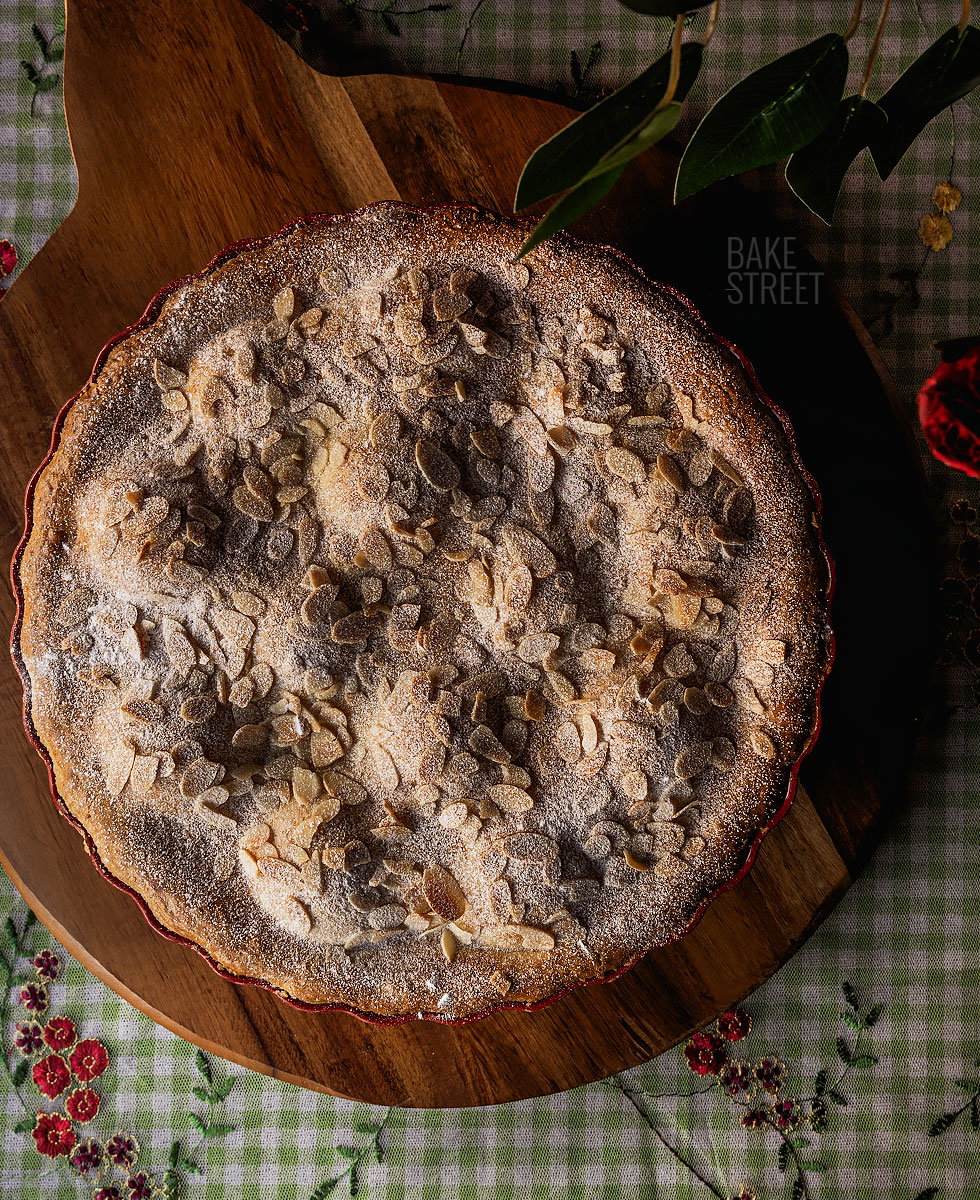
Origin of shortcrust pastry: a French gastronomic legacy and its influence on world cuisine.
Shortcrust pastry, also known as pâte brisée in French, has an origin that goes back to ancient times and whose roots are deeply intertwined with the rich culinary tradition of France. It is believed that shortcrust pastry was developed in the Middle Ages in France, where it was used in the preparation of various pastry and confectionery preparations.
The word “brisée” in French means “broken” or “broken”, reflecting the crunchy and crumbly texture of this dough once baked. It is characterized by its high fat content, specifically butter, which is mixed with flour, egg and water to form a dough that is easy to work and mold.
In its beginnings, shortcrust pastry was mainly used to prepare savory pies, such as quiche, and sweet pies, such as fruit tarts. Over time, its versatility and flavor have made it a common and traditional base for a variety of pastry and confectionery recipes around the world.
Its simplicity and versatility have made it a staple in international cuisine, being used in both sweet and savory recipes in numerous culinary cultures. Its popularity is due in part to its ease of preparation and its ability to enhance the flavor and texture of other ingredients.
Shortcrust pastry is a type of dough commonly used in pastry making for pies, tarts and other baked products. It is characterized by its brittle and crunchy texture once baked. Shortcrust pastry is mainly composed of flour, fat (usually butter), water, egg or both and salt. These ingredients are mixed until a soft and malleable dough is obtained.
In this post I talk about shortcrust pastry.
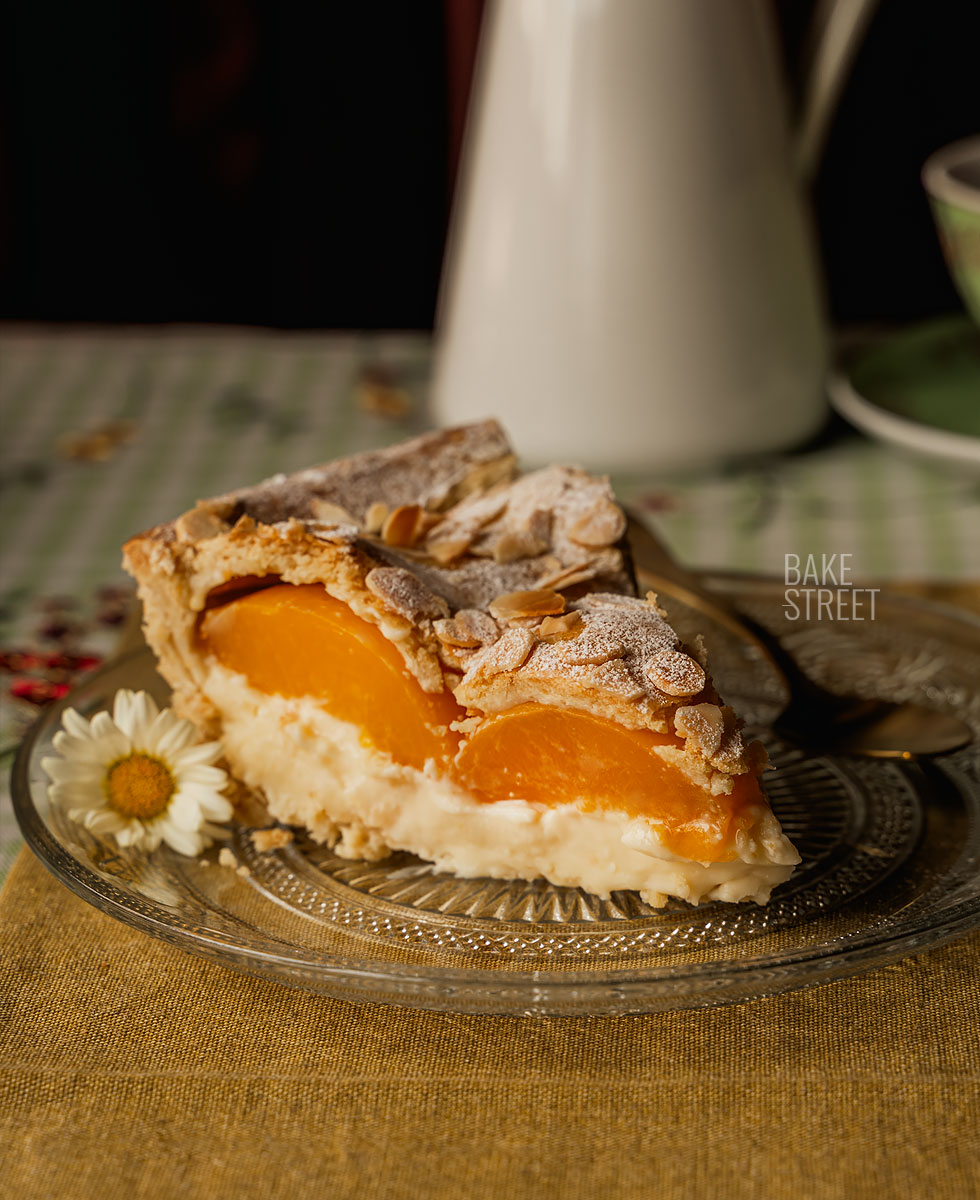
Pasta frolla, similar dough, but with differences.
The origin of pasta frolla dates back to the culinary tradition of Italy. This dough, characterized by its crumbly texture and delicate flavor, has been an integral part of Italian pastry making for centuries.
It has its roots in medieval Italian cuisine, where it was used as a base for a variety of cakes and sweet pastries. The exact date of when it was created is unknown, but it is known that it gained popularity in Italy during the Renaissance and became a staple in home and professional baking.
The basic recipe for pasta frolla consists of mixing flour with butter, sugar and eggs, until a soft and malleable dough is obtained. Something that reminds us of shortcrust pastry. Moreover, in this case, it is common to add additional ingredients, such as lemon zest or vanilla, to add extra flavor.
Some time ago I left you this Crostata al Gelo di Anguria – Sicilian watermelon cake, where I talk about crostatas and pasta frolla.
Differences between shortcrust pastry and pasta frolla.
Despite appearing to be two identical doughs, there are small details that make one differ from the other, although it is also true that they share characteristics:
- Crumbly texture: Both pasta frolla and shortcrust pastry have a crunchy and crispy texture once baked.
- Basic and inexpensive ingredients: Both doughs are made of simple and accessible ingredients; flour, butter, sugar, eggs…. The latter favors the structure of the dough and the flavor.
- Versatility: Both pasta frolla and shortcrust pastry are very versatile and can be used as a base for a variety of sweet and savory recipes.
Despite these similarities, there are also notable differences between pasta frolla and shortcrust pastry:
- Proportion of ingredients: Pasta frolla generally has a higher proportion of fat compared to shortcrust pastry, which gives it a softer and more tender texture.
- Flavor: Pasta frolla tends to be sweeter than shortcrust pastry, as it is sweetened with sugar and ingredients such as lemon zest or vanilla may be added to enhance its flavor.
- Traditional uses: Pasta frolla is typically used in the preparation of cakes and sweet pastries, while shortcrust pastry is more commonly used for both sweet and savory preparations.
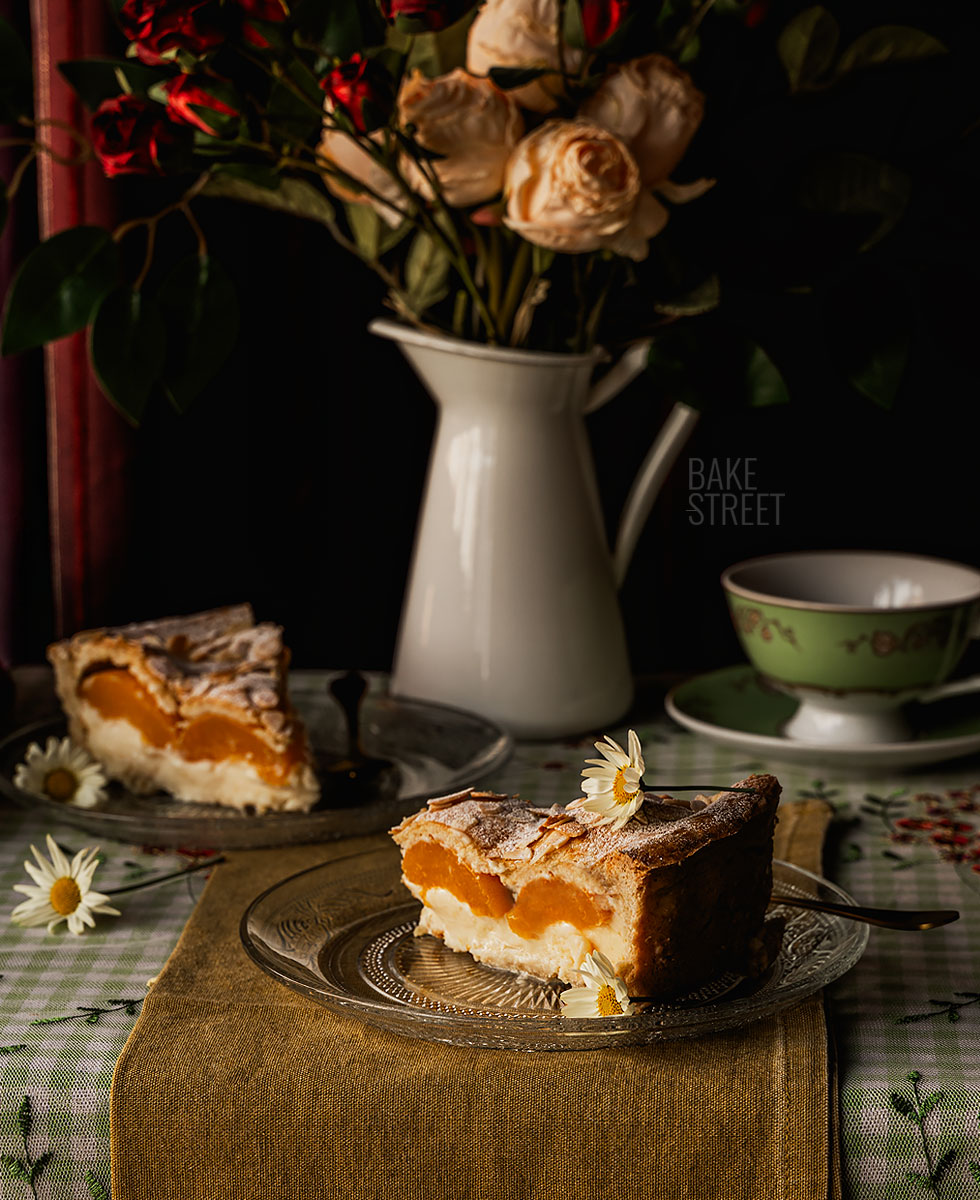
Types of shortcrust pastry.
There are several types of shortcrust pastry that, certainly, we will have confused on more than one occasion and it is completely normal… The differences between them can be determined by the ingredients used, the proportions of these ingredients and the preparation methods.
- Traditional Shortcrust pastry: This is the classic version of shortcrust pastry, made with flour, butter, water (sometimes egg) and salt. It is characterized by its crunchy and crumbly texture.
- Pâte Brisée: The French version of the traditional shortcrust pastry. It is made with flour, butter, water, salt and sometimes a little sugar. The main difference with the traditional shortcrust pastry lies in the proportion of fat, which is usually a little lower in pâte brisée.
- Pâte Sablée: This French shortcrust pastry is distinguished by its sandier texture and sweeter flavor. It is made with a higher proportion of butter and sugar than traditional shortcrust pastry, which gives it a more biscuit-like texture.
- Pâte Sucrée: Similar to pâte sablée, this French shortcrust pastry is even sweeter and more tender. It differs in the use of a larger amount of sugar and is often enriched with egg yolks, which gives it a soft, buttery texture.
Technique for working a friable dough.
When we proceed to work with a dough of these characteristics, our main purpose is to prevent gluten development. Our objective is to look for plasticity rather than elasticity. For this reason, these types of doughs should be handled as little as possible. There are two methods for handling these doughs:
- Sablage: This technique consists of mixing the fat with the dry ingredients. We must crumble the cold butter into the flour until a sandy texture is obtained. This method wraps the flour in small particles of fatty matter and, thus, waterproofs the gluten. Subsequently, eggs or water are added to give cohesion to all the ingredients.
- Crémage: Contrary to sablage, this method consists of mixing the fatty matter with the sugar. Then the egg or other wet ingredients are added and, finally, the flour is incorporated, mixing the dough as little as possible. The sweet shortcrust pastry, sablée and sucrée, are prepared in this way, and do not contain water.
Preparing the peach and cream pie.
After clarifying the types of shortcrust pastry, which despite seeming all the same or that the addition of one ingredient or another does not have to lead to another preparation, we will see how simple this preparation is.
Once we have chosen the variety of dough we want to make, we will prepare the cream cheese and yuzu pastry cream. It is very simple, the recipe that I have left you on countless occasions only that, once the cream has the perfect consistency and density after cooking, we will remove from the heat and add the cream cheese and yuzu jam. We will integrate perfectly and let it cool completely.
To accompany this cream we will use peaches in syrup. If you prefer, as long as it is in season, you can use apricots in syrup. Some time ago I showed you how to make them in this post.
You may be thinking of using other fruits… There is no problem as long as it is cooked. If we use fresh fruit, when baking the cake, it will release juices and spoil the inside. We will get an unattractive watery cream filling.
The final touch, the top decoration, is very simple. Rolled almonds and a little powdered sugar, although, of course, you can always add your own personal touch 😉
Recipe Peach and cream pie
PASTA FROLLA:
- 600 g cake flour
- 280 g unsalted butter, cold
- 2 eggs, large
- 65 g sugar
- zest of one lemon
- 7 g baking powder
1-2 teaspoons very cold water (if necessary) - pinch of salt
CHEESE YUZU PASTRY CREAM:
- 600 g whole milk
- 200 g whipping/heavy cream
- 4 egg yolks, large
- 200 g sugar
- 75 g corn starch
- 45 g cream cheese
- 70 g yuzu marmalade (orange or lemon can be used)
FILLING AND DECORATION:
- 800 g peaches in syrup, drained
- egg white for brushing
- flaked almonds
- powdered sugar
MATERIAL USED AND VISIBLE IN THE VIDEO:
- roller
- small roller (optional)
- bowls
- Teflon sheets
- medium saucepan or pot
- whisk
- silicone spatula
- ceramic mold 28 cm x 5 cm
Instructions
Prepare cream cheese and yuzu pastry cream.
- Pour the milk and cream into a saucepan. Place over medium heat and let it come to a gentle boil.
- Meanwhile, in a bowl, beat the egg yolks with the sugar and the cornstarch, previously sifted, until completely homogenized.
- Once the milk has come to the boil, pour a little of it over the yolk mixture.
- Whisk quickly to temper the yolks and prevent them from curdling into lumps.
- Add the rest of the milk little by little and mixing very well each time.
- Pour the mixture back into the saucepan and place over medium-low heat, stirring constantly. You will notice that the texture will become thicker, but it will take a while. Patience.
- Once the cream has a creamy texture, it is ready.
- Stir in the cream cheese and yuzu jam and mix until well combined.
Pour into a bowl (the larger the better because it will cool faster). - Cover with cling film to prevent it from setting and let it cool completely.
- If you wish, you can make it the day before and refrigerate it until the next day.
Prepare shortcrust pastry.
- Add in a bowl the flour together with the salt and the cold butter cut into cubes.
- Mix with the help of your hands until you get a sandy texture. It is possible that some butter pieces remain, it's okay, it's fine.
- Add lemon zest along with the eggs and mix until the dough comes together and compacts.
- Transfer the mixture to a work surface and knead for a few seconds to homogenize. We must not knead excessively because we are not interested in developing gluten in this case.
- If you notice that the dough is too brittle, add 1-2 teaspoons of cold water.
- Flatten the dough into a disc, cover with plastic wrap and refrigerate for 1 hour if it is very hot. Otherwise, you can work with it directly.

Divide the dough and line the base of the mold.
- Divide the dough into 2 pieces: one of 620 g for the base and another of 445 g for the top.
- Cover with plastic wrap and refrigerate the dough you are not going to work with.
- Stretch the dough with the help of a rolling pin, I recommend stretching it on a teflon sheet to facilitate handling and prevent it from sticking to the work surface. if you wish, you can sprinkle the work surface with flour and stretch it directly on the work surface. You should stretch the dough to a dimension larger than the mold. Remember to cover the base and sides.
- Place the dough on the mold, lightly greased with butter, and adjust without exerting pressure. If there are any uncovered areas, take scraps of dough and cover those holes.
- Run a rolling pin around the edges of the pan to remove the excess dough. Add these scraps to the piece of dough you have reserved.
- Cover with plastic wrap and refrigerate until ready to fill.
Fill the pie.
- Whip the pastry cream with the help of a whisk to soften it.
- Fill the inside of the mold with all the custard, smoothing the surface as much as possible.
- Place peach halves in syrup, previously drained, on the surface of the custard.
- Set aside.

Roll out the other piece of dough and decorate.
- Stretch the other piece of dough, you must give a dimension slightly larger than the diameter of the mold.
- Carefully place the stretched dough on the pie. Adjust very carefully.
- Run the rolling pin around the edge of the mold to remove the excess and seal the joint well.
- Refrigerate the tart while preheating the oven.

Bake.
- Preheat the oven to 355ºF/180ºC, heat up and down.
- Brush the surface of the cake with lightly beaten egg white.
- Sprinkle the surface with flaked almonds.
- Bake, placing the cake pan on the rack in the middle position, for 45-50 minutes.
- Remove and let cool completely on a cooling rack.
- Before serving, sprinkle the surface with powdered sugar.

Notes
- To make the shortcrust pastry, you must work with cold butter. If you want to speed up the process of integrating the butter with the flour, you can grate the flour instead of cutting it into cubes.
- If it is very hot, I recommend refrigerating the dough for 1-2 hours before working with it. If it is not hot, you can handle it directly without any problem.
- To roll out the dough, you can sprinkle a work surface with flour or you can do it as I show you, with Teflon sheets. This second method will make it easier to manipulate the dough to transfer it to the mold without breaking it.
- The mold I used is ceramic, but you can use a metal one. The measurements of my mold are 28 cm x 5 cm, but these can vary slightly giving also good results.
- You must be patient when carrying out the pastry cream, it takes a little time to take density. Do not feel the need to increase the heat to speed up this process, you run the risk of the cream sticking to the bottom and burning. Bringing bad taste.
- If you do not have yuzu jam, in my case I bought it in an Asian market in the center of Madrid, you can use a lemon or bitter orange marmalade. You could also use concentrated yuzu paste. I recommend you to check the amount specified to be added by the manufacturer.
- For the filling I used peach in syrup, but you can substitute it with apricot in syrup if you prefer. In this post I show you how to make it at home.
- If you are thinking of using fresh fruit, I would recommend you not to do so. The reason is that during baking the fruit will release water and therefore negatively affect the interior. The cream will be covered with a layer of water that is not very pleasing to the eye and palate. Always use fruit, previously cooked, or in syrup.
- To brush the top of the cake I have used egg white, to use a small part of the surplus we have from making the pastry cream. But, of course, if you prefer, you can brush with beaten egg.
- The sliced almonds can be substituted with chopped almonds if you prefer.
- Once baked, it can be kept refrigerated for 3-4 days.

If you feel like preparing a simple pie, without overcomplicating, but enjoying it a lot, then be sure to try this Peach and Cream Pie. I promise you that the combination of this cream with the dough is.... Total love. But if we add the point of the fruit, it is a complete wonder. I have fallen in love, completely.
Undoubtedly an ideal choice if we have visitors at home and surprise either as a dessert, coffee accompaniment, mid-afternoon or mid-morning treat. For me it is ideal at any time.
I remind you that you can watch all my videos on my YouTube channel. If you subscribe and turn on the little bell, I will be eternally grateful!
I wish you a wonderful Sunday afternoon and happy Easter!
Lots of love,
Eva
Sources: Chapela,
